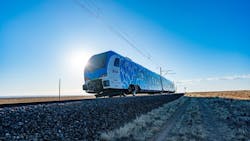Stadler's FLIRT H2 train achieves Gunness World Records title
Stadler's FLIRT H2 train has been entered into the Guinness World Records database for the longest distance of 1,741.7 miles achieved by a pilot hydrogen fuel cell electric multiple unit passenger train without refueling or recharging.
Stadler first presented its FLIRT H2 at InnoTrans 2022 in Berlin. The train's design, which integrates fuel cells and hydrogen storage systems, has been tested thoroughly, first in Switzerland and more recently on a dedicated test ring in Colorado to prove the reliability and capability of the train.
The train's design consists of two electrically powered end cars and a power pack in the middle, which contains the fuel cells and hydrogen tanks. The fuel cells convert hydrogen into electricity and send it to a traction converter. The battery then supplies the drive of the vehicle with the power required at any given time, allowing for recuperation of brake energy back to the battery.
To test this design and the length at which the train could run on one tank, a team of engineers from Stadler and ENSCO conducted the pilot on a test track at the ENSCO test center in Pueblo, Colo. The test began the evening of March 20, 2024 and the train set out for its first laps around the track.
Detailed records before, during and after the world record attempt were kept to ensure precise and transparent evidence is established.
“This world record establishes the ideal performance range of our hydrogen version of the best-selling FLIRT Electric Multiple Unit, the FLIRT H2," said Dr. Ansgar Brockmeyer, executive vice president of marketing and sales at Stadler. "This is a monumental achievement from our entire team and we are very proud to hold another record title.”
The FLIRT H2 for San Bernardino County Transportation Authority (SBCTA) is Stadler’s second Guinness World Records title winning train with alternative propulsion. In December 2021, the FLIRT Akku, the battery-powered FLIRT model, set the world record for the longest journey with a battery multiple unit in pure battery mode, covering about 139.19 miles in Germany.
“Stadler is consistently focusing on the future of rail transportation with alternative drive systems by continuously developing innovative technologies," said Martin Ritter, CEO Stadler US Inc. "By using hydrogen as a clean energy source, we are actively contributing to environmental protection and shaping the sustainable and zero emission travel of tomorrow.”
About the Author
Eman Abu-Khaled
Associate Editor
Eman Abu-Khaled is a former associate editor with Mass Transit magazine.

